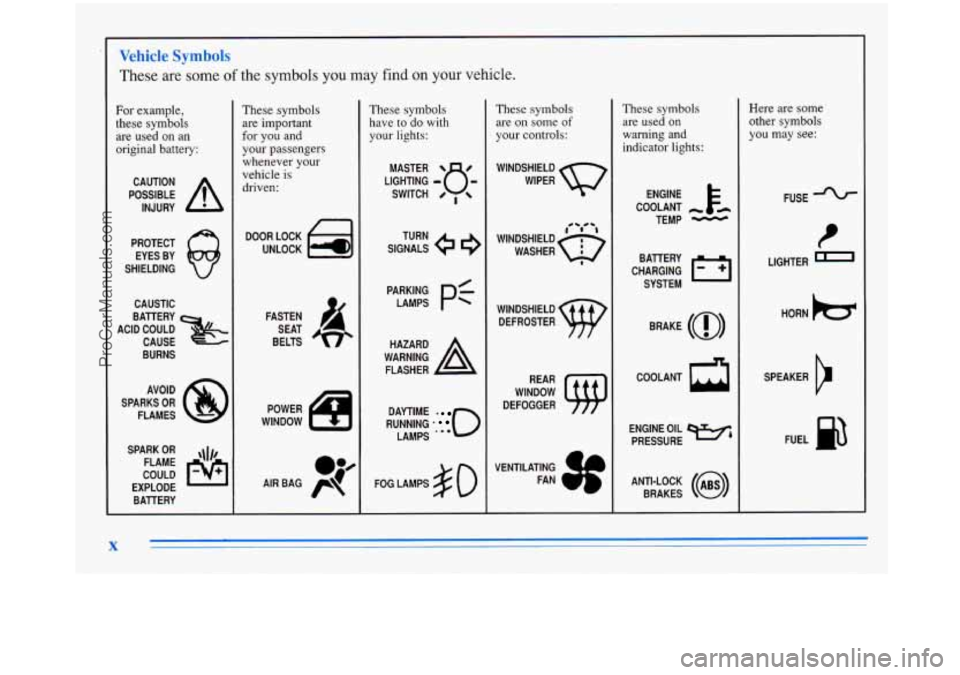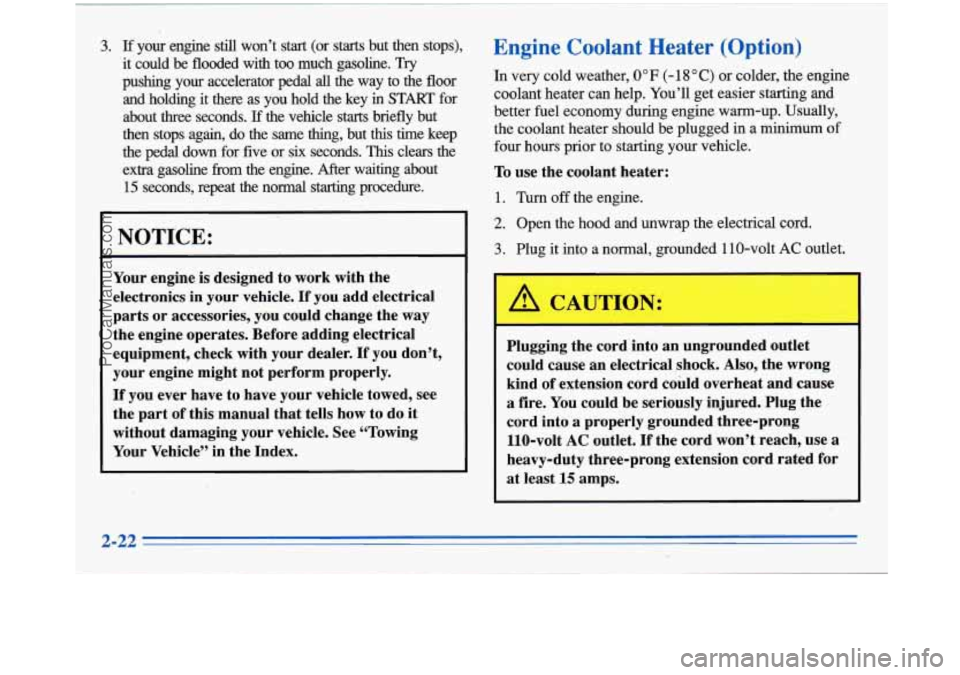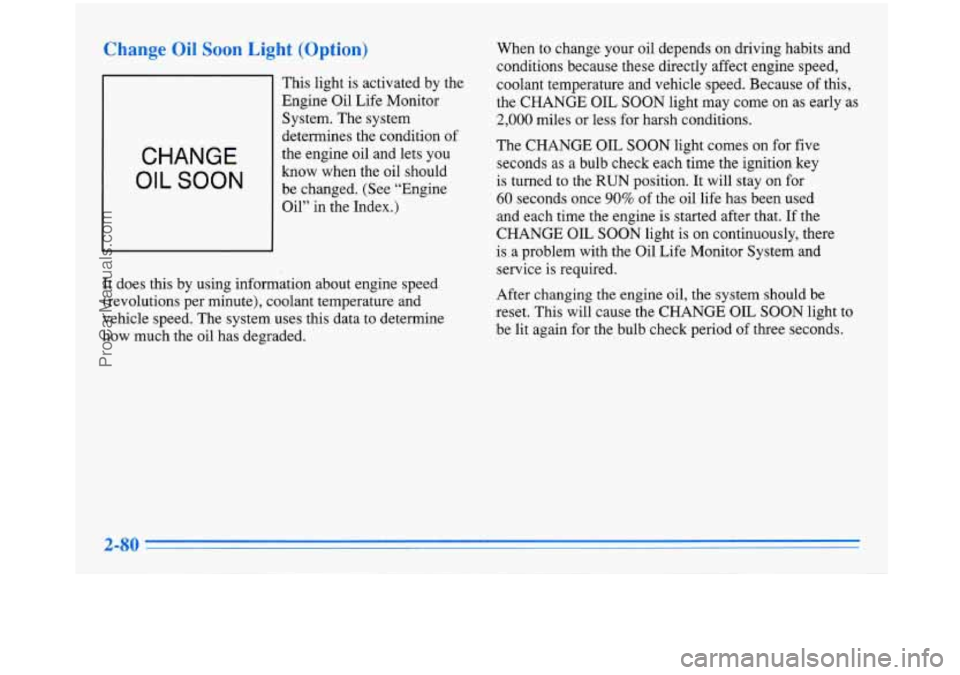1996 BUICK PARK AVENUE coolant
[x] Cancel search: coolantPage 12 of 388

Vehicle Symbols
These are some of the symbols you may find on your vehicle.
For example,
these symbols
are used on an
original battery:
POSSIBLE A
CAUTION
INJURY
PROTECT EYES BY
SHIELDING
CAUSTIC
BURNS AVOID
SPARKS
OR
FLAMES
SPARK
OR ,\I/,
COULD FLAME
EXPLODE BATTERY
These symbols
are important
for you and
your passengers
whenever your
vehicle is driven:
DOOR LOCK
UNLOCK
FASTEN SEAT
BELTS
POWER
WINDOW
These symbols
have to do with
your lights:
SIGNALS e e
TURN
WARNING
A
HAZARD
FLASHER
RUNNING
0
DAYTIME -
LAMPS '**
FOG LAMPS $0
These symbols
are on
some of
your controls:
WINDSHIELD
WIPER
WINDSHIELD DEFROSTER
WINDOW
DEFOGGER
VENTILATING FAN
These symbols are used
on
warning and
indicator lights:
COOLANT
TEMP
-
CHARGING I-1
BATTERY
SYSTEM
BRAKE
(0)
ENGINE OIL e,
PRESSURE
ANTI-LOCK
(@)
BRAKES
Here are some
other symbols you may see:
FUSE
I
LIGHTER I
HORN h=r
SPEAKER
b
FUEL n3
X
ProCarManuals.com
Page 78 of 388

I
3. If your engine still won’t start (or starts but then stops),
it could be flooded with too much gasoline.
Try
pushing your accelerator pedal all the way to the floor
and holding it there as you hold the key in
START for
about three seconds.
If the vehicle starts briefly but
then stops again, do the same thing, but
this time keep
the pedal
down for five or six seconds. This clears the
extra gasoline
fi-om the engine. After waiting about
15 seconds, repeat the normal starting procedure.
NOTICE:
Your engine is designed to work with the
electronics in your vehicle. If you
add electrical
parts or accessories, you could change the way
the engine operates. Before qdding electrical
equipment, check with your dealer. If you don’t,
your engine might not perform properly.
If you ever have to have your vehicle towed, see
the part
of this manual that tells how to do it
without damaging your vehicle. See “Towing
Your Vehicle” in the Index.
Engine Coolant Heater (Option)
In very cold weather, .Oo F (- 18 O C) or colder, the engine
coolant heater can help. You’ll get easier starting and
better fuel economy during engine warm-up. Usually,
the coolant heater should be plugged in a minimum
of
four hours prior to starting your vehicle.
To use the coolant heater:
1. Turn off the engine.
2. Open the hood and unwrap the electrical cord.
3. Plug it into a normal, grounded 1 10-volt AC outlet.
Plugging the cord’into an ungrounded outlet
could cause an electrical ,shock. Also, the wrong
kind of extension cord could overheat and cause
a fire. You could be seriously injured. Plug the
cord into
a properly grounded three-prong
110-volt AC outlet. If the cord won’t reach, use
a
heavy-duty three-prong extension cord rated for
at least 15 amps.
2-22
ProCarManuals.com
Page 79 of 388

4. After you’ve used the coolant heater,k sure to store
the cord as it was before to keep it away from moving
engine parts.
If you don’t, it could be damaged.
How long should you keep the coolant heater plugged
in? The answer depends on the outside temperature, the
kind of oil you have, and some other things. Instead of
trying to list everything here, we ask that you contact
your Buick dealer in the area where you’ll be parking
your vehicle. The dealer can give you the best advice for
that particular area.
Automatic Transaxle Operation
Your automatic transaxle has a shift lever located on the
steering column.
There are several different positions for your shift lever.
PARK (P): This locks your front wheels. It’s the best
position to use when you start your engine because your
vehicle can’t move easily.
’ A CAUTION:
I
It is dangerous to get out of your vehicle if the
shift lever is not fully in
PARK (P) with the
parking brake firmly set. Your vehicle can roll.
Don’t leave your vehicle when the engine
is
running unless you have to. If you have left the
engine running, the vehicle can move suddenly.
You or others could be injured. To.be sure your
vehicle won’t move, even when you’re on fairly
level ground, always set your parking brake and
move the shift lever to
PARK (P).
See “Shifting Into PARK (P)” in the Index. If
you’re pulling
a trailer, see “Towing a Trailer” in
the Index.
2-23
ProCarManuals.com
Page 130 of 388

Engine Coolant Temperature
Warning Light
h -
TEMP
One of these lights will come on to tell you that your
engine coolant has overheated or your radiator cooling
fans are not working.
If you have been operating your
,vehicle under normal driving conditions, you should
pull
off the road, stop your vehicle and turn the engine
off as soon as possible. I
The section “Problems on the Road,” in this
manual explains what to
do. See “Engine Overheating”
in the Index.
Engine Coolant Temperature Gage (Option)
If’ you have the gage cluster,
you have a gage that shows
the engine coolant
temperature
in degrees
Fahrenheit. Canadian
instrument panels measure
the coolant temperature in
degrees Celsius.
-If the gage
pointer moves into the red
area, your engine is too hot!
That reading means ,the same thing as the warning light.
It means that your engine coolant has overheated. If you
have been operating.your vehicle under normal driving
conditions, you should pull
off the road, stop your
vehicle and turn
off the engine as soon as possible.
The section “Problems’ on the Road,” in
this
manual explains what to do. See “Engine Overheating”
in the Index.
2-74
ProCarManuals.com
Page 131 of 388

Low Coolant Warning Light
COOLANT
LOW
When this light comes on,
the cooling system is
low on
coolant. As a bulb check, it
will come on when the
ignition in the
RUN
position and then go off.
Malfunction Indicator Lamp
(Check Engine Light)
CHECK
Your Buick is equipped
with a computer which
monitors operation
of the
fuel, ignition and emission
control systems.
If the coolant level is low, the light will come back on. If
this happens, see “Engine Coolant” in the Index for
proper cooling system fill.
After the coolant level
is returned to its proper level, the
LOW COOLANT light will go off after
20 seconds or
remain
off on the next ignition cycle. This system
is called OBD I1 (On-Board
Diagnostics-Second Generation) and is intended
to assure that emissions are at acceptable levels for
the life of the vehicle, helping to produce a cleaner
environment. (In Canada, OBD I1 is replaced by
Enhanced Diagnostics.) The CHECK ENGINE light
comes on to indicate that there is a problem and service
is required. Malfunctions often will be indicated by the
system before any problem is apparent, which may
prevent more serious damage to your vehicle. This
system is also designed to assist your service technician
in correctly diagnosing any malfunction.
2-75
ProCarManuals.com
Page 136 of 388

Change Oil Soon Light (Option)
CHANGE
OIL SOON
This light is activated by the
Engine Oil Life Monitor
System. The system
determines the condition of
the engine oil and lets you
know when the oil should be changed. (See “Engine
Oil” in the Index.)
It does this by using information about engine speed
(revolutions per minute), coolant temperature and
vehicle speed. The system uses this data to determine
how much the oil has degraded. When to
change your oil depends on driving habits and
conditions because these directly affect engine speed,
coolant temperature and vehicle speed. Because of this,
the CHANGE OIL SOON light may come
on as early as
2,000 miles or less for harsh conditions.
The CHANGE
OIL SOON light comes on for five
seconds as a bulb check each time the ignition key
is turned
to the RUN position. It will stay on for
60 seconds once 90% of the oil life has been used
and each time the engine is started after that.
If the
CHANGE
OIL SOON light is on continuously, there
is a problem with the Oil Life Monitor System and
service is required.
After changing the engine oil, the system should be
reset. This will cause the CHANGE
OIL SOON light to
be lit again for the bulb check period
of three seconds.
2-80
ProCarManuals.com
Page 144 of 388

Temperature Button
To adjust the comfort level you want maintained inside
the vehicle, push the TEMP button. If you want a
warrner comfort level, push the red arrow. If
you want a
cooler comfort level, push the blue arrow. Your comfort
setting is shown in the display.
Fan Button
The speed of the blower fan is controlled automatically
if you have the system set for AUTO. Pressing the
FAN button will display and hold the current blower fan setting.
If you want the blower fan to run at a lower speed, push
the bottom
of the FAN button. The fan speed will
decrease with every push
of the button until the lowest
speed is reached. If you want to increase the fan speed,
push the top of the FAN button. Notice the fan
indicators on the display.
Mode Controls
Press the AIR FLOW button to deliver air through the
floor, middle or windshield outlets. The system will stay
in the selected mode until the AUTO button is pushed.
Press the up arrow on the AIR FLOW button to cycle
through the available modes.
Automatic Operation
Press the AUTO button when you want the system to
automatically adjust to changes in the temperature inside
the vehicle, the outside temperature and the sun load on
the vehicle. When the system is set for automatic
operation, air will come from the floor, middle or
windshield outlets depending on the temperature inside
the vehicle, the outside temperature and sun load. Fan
speed will vary as the system gets to and maintains the
comfort setting
you have selected through the use of the
TEMP button.
To find your comfort setting, start with the system in
AUTO mode and the TEMP button adjusted to a display
of 75°F
(24"C), give the vehicle about 20 minutes to
stabilize, and adjust your comfort setting if necessary, by
using the TEMP button. The display will show the
comfort setting for
a few seconds and then it will
display the outside temperature.
If you want to see your
current automatic fan speed, airflow direction and
comfort setting, press the AUTO button.
In cold weather, the system will delay turning on the
fan, to avoid blowing cold air. The length of the delay
depends on the engine coolant temperature and the
outside temperature. Pushing the FAN, AIR FLOW or
FRONT buttons will override this delay, turn off the
AUTO setting and change the fan speed.
3-4
ProCarManuals.com
Page 224 of 388

Engine Overheating
You will find a warning light about a hot engine on your
Buick instrument panel and
if you have the optional
gage cluster, a coolant temperature gage. You
will also
find a LOW COOLANT warning light.
If Steam Is Coming From Your Engine
Steam from an overheated engine can burn you
badly, even if you just open the hood. Stay away
from the engine
if you see or hear steam coming
from it. Just turn it off and get everyone away
from the vehicle until it cools down. Wait until
there
is no sign of steam or coolant before
opening the hood.
If you keep driving when your engine is
overheated, the liquids in it can catch fire.
You or
others could be
badly burned. Stop your engine if
it overheats, and get out of the vehicle until the
engine is cool.
,
NOTICE:
If your engine catches fire because you keep
driving with no coolant, your vehicle can be
badly damaged. The costly repairs would not be
covered
by your warranty.
5-12
ProCarManuals.com